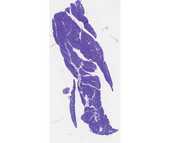Endocrine Pancreas - Islets of Langerhans
The endocrine component of the pancreas consists of multiple spherical groups of epithelial cells embedded as nodules in the exocrine pancreas. The cells in the Islets of Langerhans are not arranged into acini (as in the exocrine pancreas) but in irregular cords and clumps surrounded by a rich capillary plexus. Note that the islets are not separated from the acinar tissue by a capsule. The function of the islets is to control carbohydrate metabolism. The alpha cells secrete glucagon, which raises blood sugar, and the beta cells secrete insulin, which lowers it. There are several other biologically interesting peptides that are made by other cells of the islets. The most important identified to date is somatostatin, which is made by the delta cells. Its release locally inhibits both insulin and glucagon secretion. These cell types cannot be differentiated by light microscopy.
#107 Pancreas thin section, Acid fuchsin toluidine blue
<p>Islets of Langerhans are clearly visible interspersed within the basophilic acini of the exocrine pancreas. Keep in mind the classes of hormone producing cells are not distinguishable. For a more detailed description of the exocrine pancreas see part two of the gastrointestinal system lab.</p>
